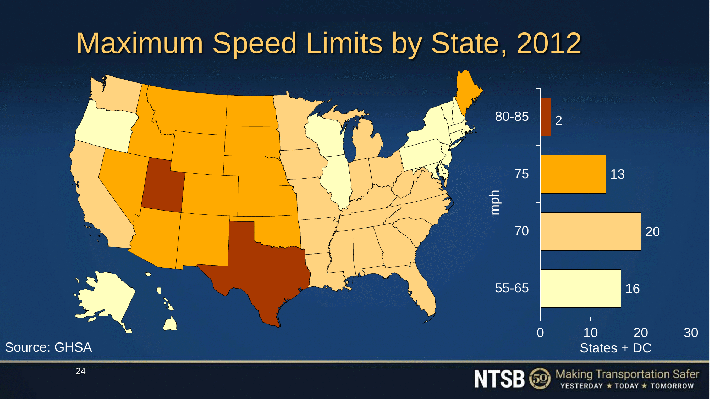More than 112,500 people lost their lives in speed-related crashes from 2005 to 2014, accounting for 31 percent of all traffic deaths in America over that period. In a draft report released earlier this week, the National Transportation Safety Board says excessive speed is a deadly problem in our nation's transportation system -- one that federal and state officials aren't doing enough to address.
The recommendations presented at an NTSB board meeting on Tuesday represent a breakthrough for the agency, which is known for investigating plane and railroad disasters. Traffic crashes are less spectacular but cumulatively much more dangerous, claiming tens of thousands of lives each year. When the agency does turn to road safety, it has tended to focus on impaired driving and seat belt use. A thorough look at the dangers of speeding and how to prevent it is a welcome departure.
"The simple truth is that speeding makes a crash more likely. In a crash that’s speeding related, you’re more likely to be injured, your injuries are more likely to be severe, and you’re more likely to die," NTSB Acting Chairman Robert L. Sumwalt said in his opening statement at the board meeting. "And that’s true whether you’re the speeding driver, another driver, a passenger, a bicyclist, or a pedestrian."
Unlike driving drunk or not wearing a seat belt, which have been the subject of sustained national attention for decades, there's little stigma against driving too fast. "Speeding has few negative social consequences associated with it, and does not have a leader campaigning to increase public awareness about the issue at the national level," Sumwalt said. "We hope that this study helps to bring the issue of speeding back into the spotlight."
The NTSB's 19 recommendations should be a wake-up call, especially to the Federal Highway Administration (FHWA), state legislatures, and transportation and police departments across the country.
First off, the NTSB says, the way transportation engineers around the country have been setting speed limits for decades is causing more problems than it solves. Typically, engineers measure how fast drivers are traveling on a road, then set a speed limit so that 85 percent of drivers fall below it, and 15 percent of drivers are above. It's called the 85th percentile rule. The NTSB points out that it's based on research from rural roads in the 1950s and aims to accommodate speeding drivers, rather than reduce crashes.

The board told the FHWA it should replace the 85th percentile rule with guidelines proven to improve safety. "In general, there is not strong evidence that the 85th percentile speed within a given traffic flow equates to the speed with the lowest crash involvement rate," the NTSB says. "Alternative approaches and expert systems for setting speed limits are available, which incorporate factors such as crash history and the presence of vulnerable road users such as pedestrians."
The way motorists think about speed also needs to change. Using GPS or sign-reading sensors, cars can now alert drivers when they're speeding, and even prevent motorists from exceeding the limit. The NTSB said the availability of these features should be included in car safety ratings, but didn't endorse them as mandatory equipment.
The board did, however, have strong recommendations backing more speeding enforcement -- and camera enforcement in particular.
Studies consistently show speed cameras to be effective at reducing fatalities and injuries, but they're allowed in only 15 states and the District of Columbia. A total of 28 states have no laws enabling speed cams, and another seven prohibit them. The NTSB urged states to enable automated enforcement on their roads, and said states that already have speed cams should "remove operational and location restrictions" that prohibit their use. New York state, for example, limits speed cameras to a select number of school zones and allows them only to be operated during specified hours -- a restriction that achieves no safety objective.
There's also a need for better speed camera technology, the NTSB says. The United States relies on fixed site cameras, but "point-to-point" enforcement, which tracks vehicle speed over a greater distance, has proven effective in Europe, Australia, and New Zealand and should be used and evaluated here.
Traffic safety advocates hailed the NTSB's report.
"We hope this report will continue to bring attention to the important yet often overlooked role of speeding in traffic injuries and fatalities for everyone who uses our streets," said the National Complete Streets Coalition.
“For too long, proven policies to reduce speeding in our communities have been held hostage by outdated standards, costing more than 10,000 lives lost each year,” said Leah Shahum, director of the Vision Zero Network. "We urge every state and community to adopt NTSB’s recommendations to stem the tide of preventable suffering on our roadways."
“Speed is just as significant a factor in traffic deaths as alcohol," said Jake Nelson, director of traffic safety advocacy and research for the American Automobile Association. "AAA hopes the NTSB report and recommendations spur a constructive and long overdue discussion about how to curb speeding and improve safety on our nation’s roadways.”






